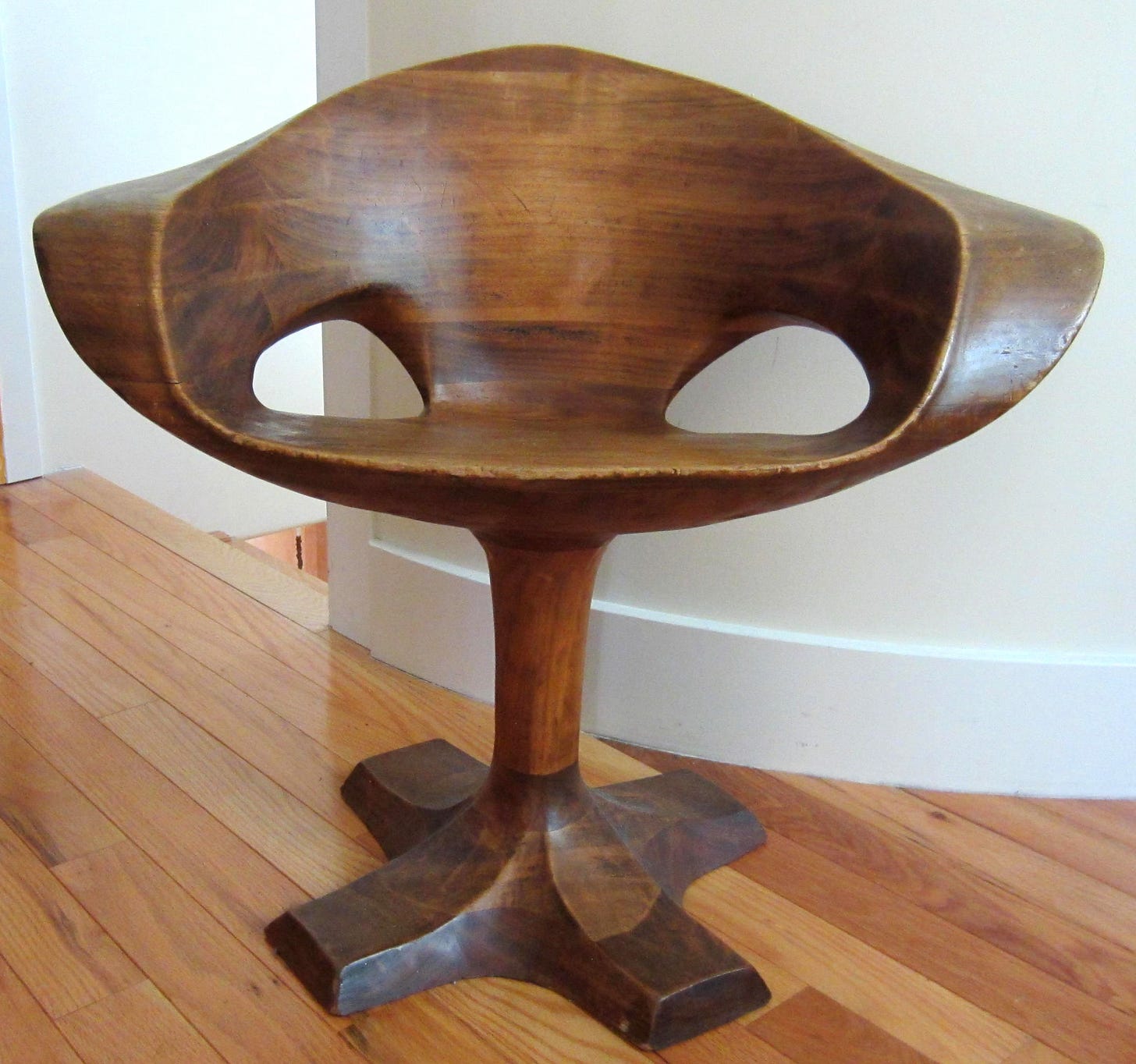After a summer-'69-to drifting around/ return to college. Pouring molten metal again and building a wooden chair.
https://www.amazon.com/dp/B0BBDNQV2T
(Excerpted from my memoir, TWELVE DEAD FROGS)
When CCAC in Oakland (now California College of the Arts, San Francisco) started up again in the fall I wondered if I could successfully concentrate enough on school to actually finish my BFA (my emotional problems regarding my wife still took their toll, and I missed my kids). But, somehow, I pulled myself together to give it a try. Within a few days I was happily back in the groove, working again, thinking up and building sculptures that seemed to meet with the approval of my contemporaries. I got big compliments on my work from artists I respected, like Teacher/friend C.G. Simonds, painter Perry House (was Houston-based), Dale Lanzone (a past federal bureaucrat in Washington, now NY art gallery exec.), Joe DiVincenzo (who recently illustrated a series of Grateful Dead portraits), sculptors Ron Sevier, Al Holsapple, Patricia Frischer, Don Rich, and others. And with the creation of each new piece, my confidence and self- esteem grew stronger.
For the first time in many years I felt in accord with my younger self, the one in Chicago, age 5-8, the younger me who spent hour after hour alone in the basement making constructions out of wooden orange crates or whatever was available. I had rejoined my true self. So, To hell with grades and other classes, I thought. I would just pour bronze.
CUTTING LOCKS (1969)
One of the perks of my teacher’s assistant job was that I had my own set of keys to the foundry facility and could use the studio at the college any time I wanted, day or night. So I got a lot of work done during off hours. But occasionally, as with any institution of higher learning, there were a few crossed wires. At some point the school cop, a guy named Morrie, decided that the cabinets containing the power tools should be locked up each night, for security purposes. It was obvious that he considered the long-haired hippies on campus to be prime candidates for potential thievery. How he imagined that these young criminals could somehow first break into the heavily padlocked foundry in the first place, I’ll never know. But he did.
After traveling over from my house one evening (I had found a room for $25 per month in Oakland) to complete a sculpture for the next day’s critique, I discovered to my chagrin that I had no access to the power grinder, which I absolutely needed to complete my job. I was disgusted that somebody could have come into “my studio” and deprived me of a crucial tool, was “fucking with my precious time.” Without as much as a second’s hesitation, I picked up the nearby bolt cutters, a tool Morrie hadn’t been smart enough to lock away, gripped the lock with its blades, applied pressure to the two-foot long handles, and snapped it open without much of a problem.
The next day I heard something about my infraction from Charlie, who of course got a kick out of anything that upset the bureaucracy at CCAC. I told him that they had no business doing that, locking me out of my tools. He agreed. But a couple of days later it happened again.
I had driven in again to do some work and discovered a new (bigger!) lock hanging off the power tool cabinet. Again, I grabbed the bolt cutters (didn’t Morrie understand what this tool was used for?) and snapped it right off. No one was going to waste my evening of sculpting. No way! Well, this time the shit really hit the fan. No cop likes his authority to be questioned, much less twice in a row. There was a fairly big stink, resulting in some school official actually entering the dusty, smelly, cavernous foundry to talk over the situation with us. But Charlie was a well-respected teacher and we emerged victorious, forever straining my relations with Morrie. He seethed, and quietly waited to get even.
THE TEACHER’S CHAIR (1969)
At the same time, I was doing my foundry work at CCAC, I attended a furniture design class at the woodworking studio that was right next door. I figured I would enjoy making things out of wood while I learned how to use some of their sophisticated equipment. Somehow, I was able to convince the teacher, Mr. Judson, to let me make a chair out of solid maple, a modern chair that stood on a singular pedestal, like the kind he produced for rich people (only rich people could have afforded his designer prices).
As the semester progressed, Mr. Judson showed me how to make the chair, explaining one step after another. It was simpler than I could have imagined. He said I first needed to create a six-inch scale model in clay. Then I could cut it into slices with a thin piece of wire, each layer representing a 2” section of the final, full-sized item. Next, I would trace around the little, cut-out clay shapes on graph paper, which allowed me to easily duplicate the layers on a life- sized grid. Finally, I’d create the full-sized wood pieces from the 2” thick boards – cut out each layer precisely with a jigsaw, square them with a joiner and planer – and glue it all together. A lathe would be used to fashion the pedestal base. With some chiseling on the seat and sides, and sanding overall; voila!
Mr. Judson, a world-renowned furniture designer at the time, said that usually he only allowed graduate students to produce something as complicated as an original chair, but that he had made an exception in my case. And not surprisingly, my finished chair looked somewhat similar to his prized designs (anything with a pedestal base would have looked that way to Morrie!).
When I finally happened by CCAC before Christmas break to pick up the chair, Morrie-the-cop got his chance to pay me back. I had barely lifted my chair off the top of the workbench when I heard his cop voice, loud and stern.
“Stop! Rick! Put that down!” he shouted out of nowhere. I looked over toward the door of the woodworking studio, about twelve feet away, and saw Morrie, his hand pressed against his holster, beady- eyed, lips pursed.
“Put that chair down, right now!” he ordered again. “But it’s my chair, Morrie,” I said, in shock from the interruption.
“No, it isn’t!" he tersely responded. “It’s Mr. Judson’s chair. And you better put it down this second.
“And CAREFULLY!”
I lowered it slowly back down the six inches to the table, and tried again to convince him that it was mine, but he was sure he knew better. He was convinced I was a thief (that much was proven by my repeated “breaking and entering” of the foundry tool locker), and now I was a liar, too. By then I had tears in my eyes.
I was embarrassed when another student happened in and saw my wet face. I had never been good with confrontation or being reprimanded, and Morrie had dressed me down pretty good. As I left, I told him he’d learn at some point up the road that he had been wrong. So I had to leave my precious chair behind until the first week in January 1970, worrying throughout the semester break that it might somehow be stolen.
The few times that I saw Morrie after the Christmas break, after I was able to pick up my chair, he avoided me, made no eye contact. And Mr. Judson gave me a “B” for the class. When I asked him about the (lousy) grade, he said it had nothing to do with the quality of my chair. Then what was the grade based upon? That’s all I worked on the entire semester. He mumbled something about “overall woodworking skills,” but I wasn’t impressed with that logic. How had Mr. Judson felt when Morrie explained (proudly) that he had caught me stealing one of his chairs? How embarrassed had the teacher been to admit that it was actually mine. After all, Morrie had thought my chair was every inch as good as a Judson original. In my book, I call that an “A.”
—————







"I had rejoined my true self." I'm convinced that's the "game" we come here to "play." Well played.